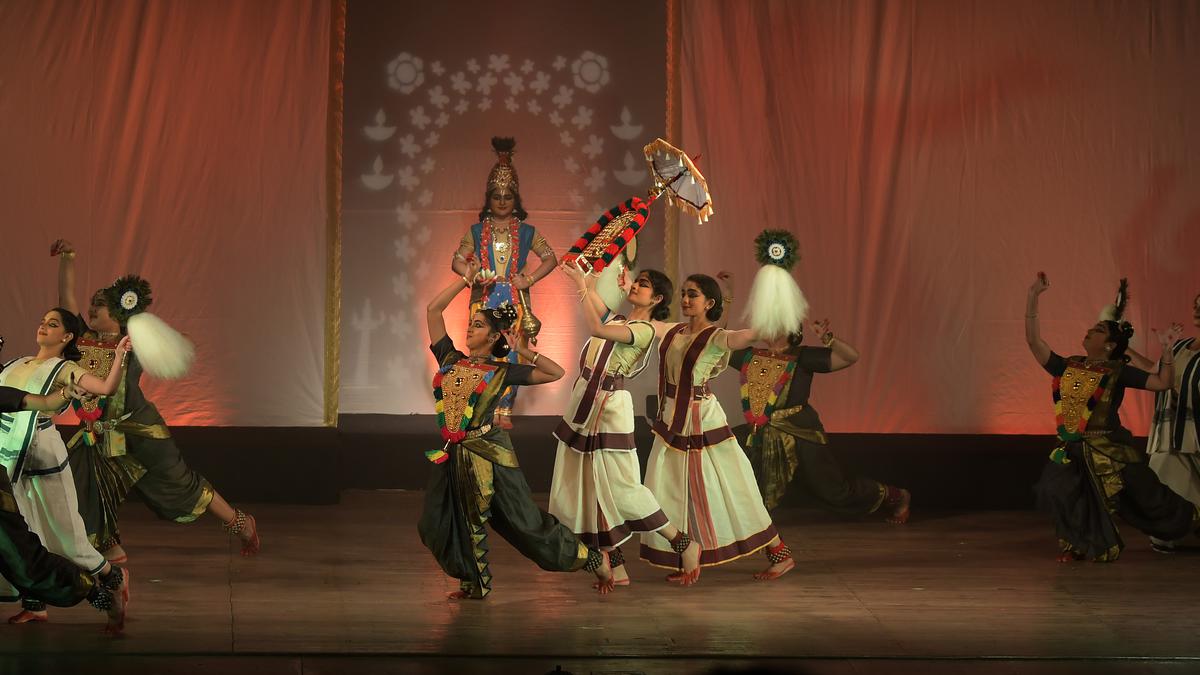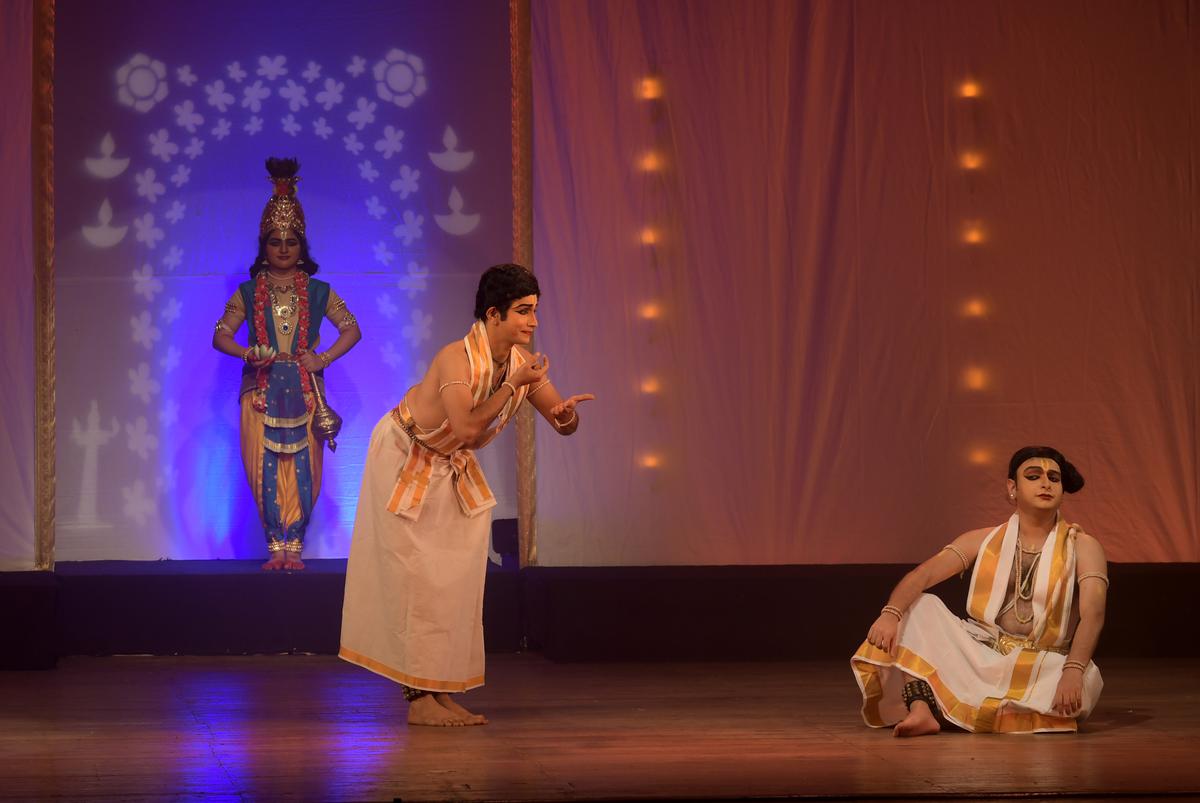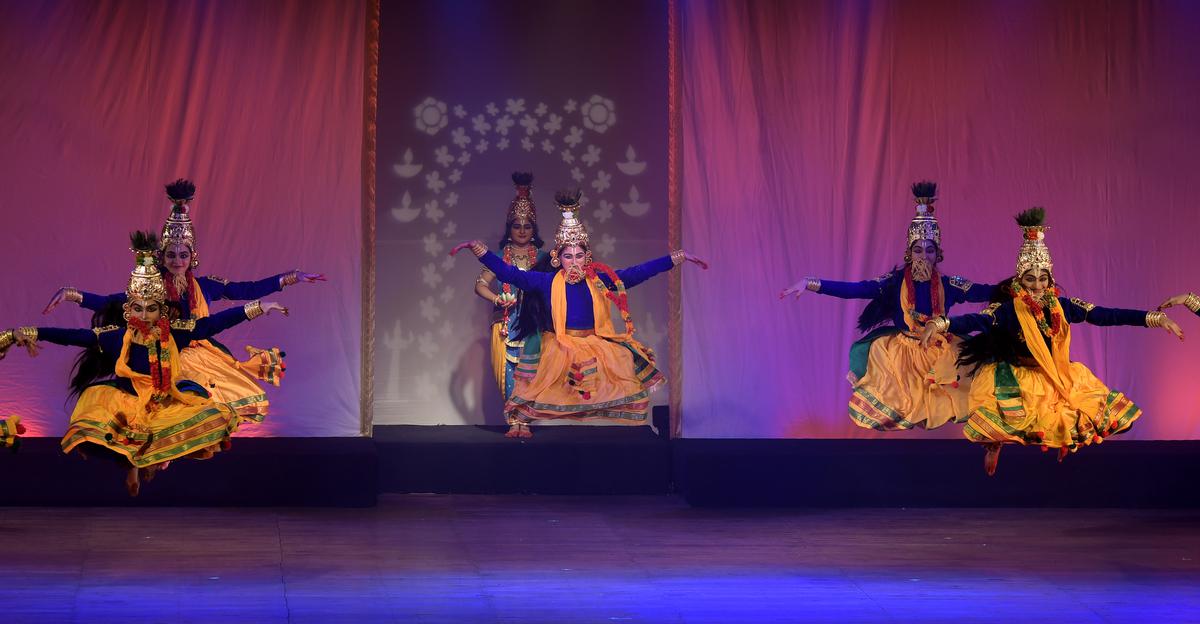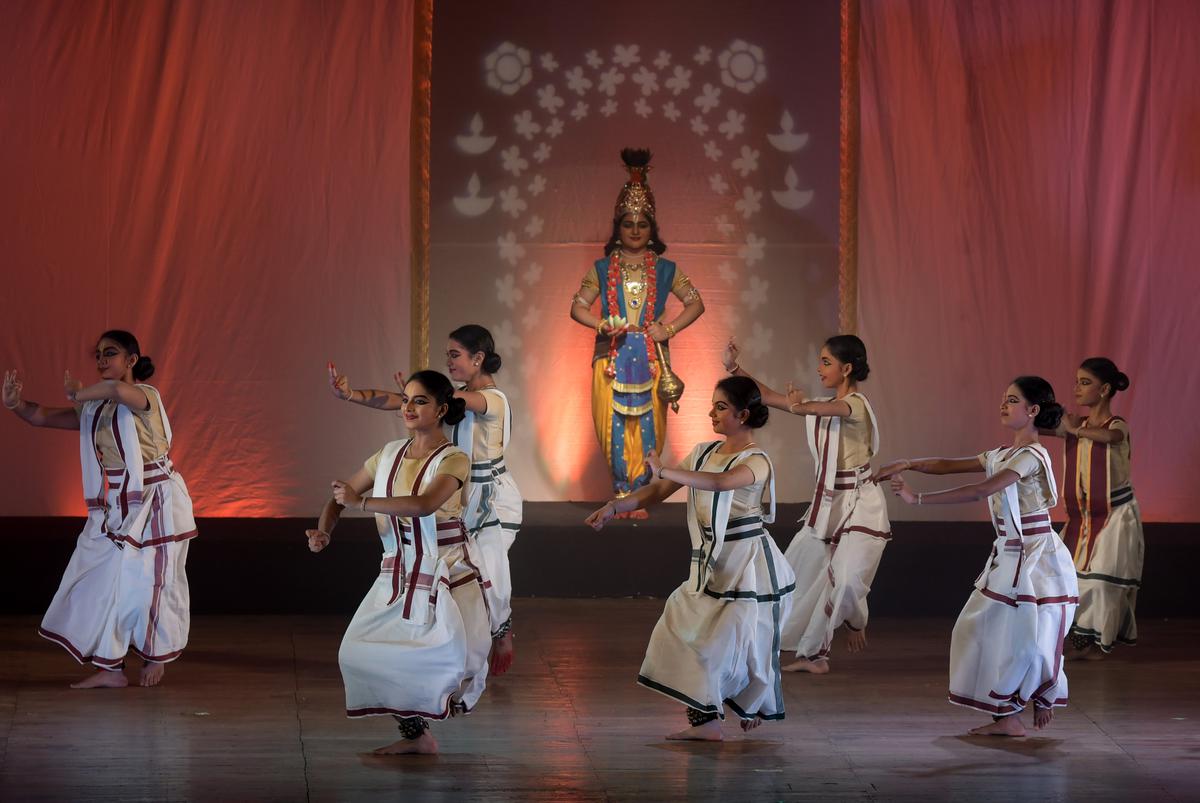
‘Agre Pashyami’: A fine blend of verse and visuals
The 100th dasakam of Narayana Bhattadri’s Narayaneeyam is a significant one; the ailing author is blessed with a vision of Krishna. He breaks into the verse ‘Agre Pashyami’, translating as, ‘As I see in front of me’, to give a keshadi pada varnanam, head-to-toe description of what he saw.
‘Agre Pashyami’ was also the title of the mega dance theatre production based on the Narayaneeyam, conceptualised and presented by scholar Dushyanth Sridhar and choreographed by veteran Bharatanatyam teacher Anitha Guha. It was a colourful, dynamic, devotional spectacle, with expertise and finish not often seen. It had artfully tailored music by Rajkumar Bharathi, soundscape design by Sai Shravanam, costumes and theermanams by Anitha and performed in perfect sync by talented dancers from her Bharathanjali and other schools.

Thematic dance performance ‘Agre Pashyami’ presented at Narada Gana Sabha, Chennai, in February 2023.
| Photo Credit:
VEDHAN M
As per the back story Narayaneeyam — the suffering Bhattadri was advised by Thunchaththu Ezuthachan, a spiritual Malayalam litterateur, to ‘start with the fish’, and consequently writes of the dasavataras, ‘Agre’ presented this episode as well as some avataras such as Kurma, Varaha, Nrisimha, Rama and Krishna.
Every segment was layered with the music, the lyrics, the costumes and in some instances, the local dance style. The attention to detail and the seamless performances surpassed her previous presentations. Anitha’s finesse seems to get better every time.

Thematic dance performance ‘Agre Pashyami’ presented at Narada Gana Sabha, Chennai, in February 2023.
| Photo Credit:
VEDHAN M
Though there was enough theatrics, the tone remained devotional. Besides the lyrics, having a Venkateshwara framed in an arch in the background, as a witness to the goings on, and presenting various forms of Vishnu at another point underlined the intent.
Guruvayoor, the place where Narayaneeyam was written, was not forgotten. ‘Agre’ opened with a prayer (taken from Krishnageeti, the text for Krishnattam Kali, followed by unfamiliar syllables ‘…rin ta ta dina…’ (P.R. Venkatasubramanian) for the glimpse of the Guruvayoor-specific temple dance drama style of Krishnattam Kali, ending with a Mallari, with reference to the ‘Seeveli’ procession in the Guruvayoor temple, with elephants and people adorned in the customary white and gold.
Creation of Narayaneeyam
The story of Poonthanam and Bhattadri, when the latter refused to edit the Malayalam devotional work of the former and Bhattadri’s suffering, his meeting with Ezuthachan that led to the creation of Narayaneeyam was portrayed clearly, the picturisation taking off where the commentary ended.

Thematic dance performance ‘Agre Pashyami’ presented at Narada Gana Sabha, Chennai, in February 2023.
| Photo Credit:
VEDHAN M
‘Vadavarayai matthaki Vasugiyai ….’ ( Silappadhikaram) in chatusra heralded the samudra manthan. Kurma, the tortoise avatara of Vishnu, crawls across the stage to the accompaniment of Jayadeva’s Dasavatara shloka. The light-footed Shiva appears soon after to the chanting of ‘Namaste Rudramanyava..’. He performs a rigorous jathi, drinks the kalakootam poison and is stopped by Parvathi. The graceful Lakshmi appears to a verse from Narayaneeyam and a solkattu, ‘Thanga silambu..’ (Venkatasubramanian) with the lilting kalyanam scene in Devagandharam (Purandaradasa’s ‘Ksheerabdi’), Desh and Hamsanandi.
The stage buzzed with the protagonists and narrators, each moving in perfect sync. Their accurate timing and good standard of dance were notable. Meanwhile the Kurma avatara is not over — Vishnu is now centre stage with his various forms (Ranganatha, Venkatesa, Vittala, Guruvayurappa) with special chants or songs for each.
Detailed portrayal
This level of detailing continued for the other episodes. The production remained seamless with clever sound design and excellent timing. Occasionally, there was a gap in narration, as in Bhoodevi’s recollection of her happy past just after her abduction in Varaha avatara episode. The sudden change from unhappiness to happiness was confusing.
There were playful moments too such as when Narada appears and tells Hiranyaksha about Vishnu saving Bhoodevi in the Varaha episode. He mocks at the asura, ‘Kashtam kashtam…’ The agitated asura goes, ‘dingdingding thaita tham’. Such situation-enhancing jathis were rendered with sound effects as well. Anitha perhaps is a dramatist first and then a visualiser.
Most visually dramatic portrayal that evening was of the Nrisimha avatara pose. Accomplished with split-second timing, the hard working dancers and the lighting expert (Murugan) deserve credit. Bhattadri sitting on the side enjoyed the episodes and added authenticity to ‘Agre Pashyami.’
The melodious ‘Neela megha shyama kodandarama..’ (Yamuna Kalyani) and Hanuman’s escapades were the highlights of Rama avatara episode, as were the different facets of Krishna presented. Anitha let loose her imagination to present Kalinga Narthana, using Mohiniyattam in the rasa kreeda sequence. The two-hour show ended with Bhattadri’s ‘Agre pashyami’ moment, the moment of the vision. With many Krishnas, the adage of ‘Krishna is everywhere you see’ came home strongly.
‘Agre Pashyami’ could have been a visual and aural treat, but for the ear-deafening volume in the auditorium.
Stay connected with us on social media platform for instant update click here to join our Twitter, & Facebook
We are now on Telegram. Click here to join our channel (@TechiUpdate) and stay updated with the latest Technology headlines.
For all the latest Entertainment News Click Here
For the latest news and updates, follow us on Google News.

